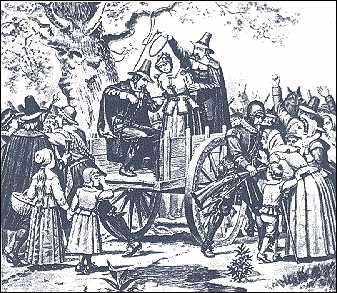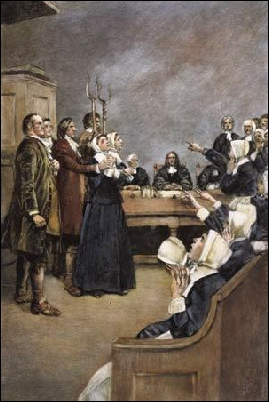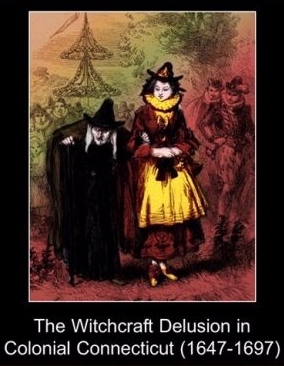The Witchcraft Persecution of Goody Knapp
By the 1650’s a preoccupation with the supernatural and a hysterical effort to root out those who “covenanted” with the spectral world had swept through Connecticut
Goodwife Odell -- either the daughter or wife of William Odell (b. 1601) -- played a key role in the conviction of Goody Knapp
GOODY KNAPP
from appalachian_home.tripod.com/
goody_knapp.htm
Goody Knapp was executed for alleged witchcraft in Fairfield, Connecticut in 1653. Many of the details of her case remain unknown, and much of what we do know is related to us through the trial of another Fairfield woman, Goody Staples. It is unclear from the documentation if Goody Knapp ever made a confession. Some testimonies maintain that she intimated an allegiance with the dark powers, while others claim that she maintained an unwavering denial of guilt until the moment of her death.
The primary basis for her conviction was a common one in the days of witchcraft hysteria - that of the presence of "witch's teats," or marks by which witches were supposed to have suckled their familiars. (Familiars were small and sometimes invisible animals believed to be sent to aid the witch in carrying out acts of maleficium.) The body of the accused was searched diligently, with clinical precision; any unusual growth or mark upon the skin was suspect and hailed as evidence of witchery.
After Goody Knapp's conviction, she was visited in gaol by other women of the town, and many of the appeals they made to her to rescind are striking. A Goody Pell remarked that "before she was condemned, she might think a confession a means of taking away her life, but now she must die and therefore must discover (expose) all." Another woman advised her to "do as the witch in the other town had done, that is, to discover all she knew to be witches." And one Elizabeth Brewster told Goody Knapp "if you keep it a little longer till you come up to the ladder, the devil will have you quick if you reveal it not until then." Knapp replied "take heed the devil have not you, for she could not tell how soon she might be her companion."
As was the case with most women accused of witchcraft, a great amount of pressure was put upon them both during their trial and after their conviction to accuse other townspeople of the same offense. Frequently, the psychological strain endured by the condemned was enough to manifest itself in delusions or mental breakdowns that seemed self-incriminating by nature.
One of the chief designs of Goody Knapp's fellow townspeople was to extract from her an accusation against Goody Staples, who had been long suspected of evil doings. Goody Knapp, however, would never speak against Goody Staples, saying only that "the truth is that you would have me say that Goody Staples was a witch… I know nothing of Goodwife Staples, and I hope she was an honest woman." And Goodwife Staples, for her part, never spoke against Goody Knapp, saying during the latter's trial "why should she [Knapp] confess that which she was not… and if Knapp were one she would confess it."
During one session of questioning and visitation after her conviction, the strain bearing upon Goody Knapp was beginning to show. To one interrogator she replied, "hold your tongue, you know not what I know, I have ground for what I say, I have been fished withal in private more than you are aware of…." Discussion continued in this vein, and the position of Goody Knapp became more and more uncomfortable. She reportedly declared "that a woman in the town was a witch and would be hanged within a twelvemonth." In an increasingly agitated state, she made tantalizing references to "Indian gods" and "shining things which shine lighter than the day." And when a friend "told her she was now to die, and therefore she should deal truly, she burst forth into weeping and desired [the visitor] to pray for her, and said she knew not how she was tempted: 'never a poor creature was tempted as I am tempted; pray, pray for me.'"
Like all such events, the hanging of Goody Knapp attracted a large crowd of onlookers. No sooner had she been pronounced dead and "cut down" from the gallows than a large group of women pressed forward "looking for the marks of a witch upon the body." They proceeded to "tumble the corpse up and down;" then "several… said they could find none" and a heated discussion ensued. Goodwife Staples seemed particularly upset: "wringing her hands and taking the Lord's name in her mouth… she said 'will you say these are witch's teats? They are not.'"
Witnesses would later remember that she "handled the said teats very much" and "pulled them with her fingers as though she would have pulled them off." Presently, Goody Staples called upon Goody Lockwood to come and reiterated her protest: "if these be teats, here are no more teats than I myself have, or any other woman, or you either if you would search your body." Goody Lockwood answered tartly: "I know not what you have, but for myself, if any find such things about me, I deserve to be hanged as she was." There was still more "handling" of the corpse, and more argument. Goody Staples persisted in her objections, although "several of the women cried her down and said they were teats."
At length, the group was joined by a certain Goodwife Odell, who had "searched" the convict prior to her execution with a court-appointed committee. Goody Odell "showed them the marks that were upon her [Knapp] and asked what are these and they all wondered, and Goodwife Staples in particular, and said they never saw such things in their life before."
Goody Knapp was one of eight women to be tried for witchcraft in Connecticut prior to 1660; seven of these, including Knapp, were executed. This was followed by the "Hartford Outbreak" of 1662-5, considered New England's largest 17th century witch hunt. 17 persons were tried, and of those, 4 were executed. Another event took place in 1692, concurrent with the early months of the infamous witch hunt in Salem, Massachusetts. Known as the "Fairfield Outbreak," this event produced only a handful of accusations, two of which went to trial, and both of the suspects were acquitted. The "Fairfield Outbreak" marked the beginning of the end for accusations of witchcraft in New England.
'One (blank) of Windsor arraigned and executed at Hartford for a witch'--the first known execution for witchcraft in New England. I have found no mention elsewhere of this Alse Young." J. HAMMOND TRUMBULL'S _Observation on Grant's Entry_.
"Who then was the 'witch' with whose execution Connecticut stepped into the dark shadow of persecution? She has been called Mary Johnson, but no Mary Johnson has been identified as this earliest victim. Whose is that pathetic figure shrinking in the twilight of that early record? We could think of her with no less kindly compassion could we give a name to the unhappy victim of the misread Word of God, who was led forth
THE FIRST EXECUTION FOR WITCHCRAFT IN NEW ENGLAND
A secret long kept made known -- Winthrop's journal entry probably correct -- Tradition and surmise make place for historical certainty -- The evidence of an eyewitness -- A notable service.
ALSE YOUNG. Windsor, 1647.
"May 26, '47 Alse Young was hanged." MATTHEW GRANT'S Diary.
"The first entry (the executions of Carrington and his wife being next mentioned) supplies the name of the
to a death stripped of dignity as of consolation: who to an ignorance and credulity, brought from an old world and not yet sifted out by the enlightenment and experience of a new, yielded up her perhaps miserable but unforfeited life. Here is the note which in all probability establishes the identity of the One of Windsor arraigned and executed as a witch--'May 26, 47 Alse Young was hanged.'" _"One Blank" of Windsor_
(Courant Literary Section, 12, 3, 1904), ANNIE ELIOT TRUMBULL.
http://www.fullbooks.com/The-Witchcraft-Delusion-In-Colonial-Connectic3.html
'GOODWIFE KNAP'
THIS was one of the most notable of the witchcraft cases. It stands among the early instances of the infliction of the death penalty in Connecticut; the victim was presumably a woman of good repute, and not a common scold, an outcast, or a harridan; it is singularly illustrative of witchcraft's activities and their grasp on the lives of the best men and women, of the beliefs that ruled the community, and of the crude and revolting practices resorted to in the punishments of the condemned, and especially since in its later developmen it involved in controversy and litigation two of the great characters in colonial history, Rev. John Davenport, one of the founders of New Haven, and Roger Ludlow, Deputy Governor of Massachusetts and Connecticut.
Goodwife Knapp of Fairfield was "suspicioned ." That was enough to set the villagers agog with talk and gossip and scandal about the unfortunate woman, which poisoned the wells of sober thought and charitable purpose, and swiftly ripened into a formaI accusation and indicment.
Pending her trial the prisoner was committed to the house of correction or common jail for the safe keeping of 'refractory persons' and criminals.
What terrors of mind and spirit must have waited on this 'simple minded' woman, in the cold, gloomy, and comfortless prison, probably built of rough logs, with a single barred window and massive iron studded door, a ghost haunted torture chamber, in charge of some harsh wardsmen.
Knapp was duly and truly, and sentenced to death by hanging, the usual mode of execution. No witch was ever burned in New England.
From the day sentence was pronounced until the hanging took place, out in Try's field beyond the Indian field, in view of the villagers, whose curiosity or thirst for horrors or whose duty led them there, this prisoner of delusion was made the object of rudest treatment, espionage, and of inhuman attempts to wring from her lips a confession of her own guilt or an accusation against some other person as a witch.
The very day of her condemnation, a self-constituted committee of women, with one man on it, -- Mistress Thomas Sherwood, Goodwife Odell, Mistress Pell, and her two daughters, Goody Lockwood, and Goodwife Purdy, -- visited the prison, and pressed her to name any other witch in town, and so receive such consolation from the minister as would be for her soul's welfare.
Mistress Pell seems to have been the chief spokeswoman, and each member of the committee served in some degree as an inquisitor, or exhorter, not to repentance, but to disclosures. Baited and badgered, warned and threatened, the hapless prisoner protested she was innocent, denied the charges made against her, told one of the committee to 'take heed the devile have not you,' and also said, 'I must not render evil for evil. . . . I have sins enough allready, and I will not add this [accusing another] to my condemnation.' And at last in agony of soul she made that pathetic appeal to one of her relentless tormentors, 'neuer, neuer poore creature was tempted as I am tempted, pray, pray for me.'
But even after death on the scaffold, the witch-hunters of the day did not refrain from their ghoulish work, but desecrated the remains of Goodwife Knapp at the grave side in their search for witch marks.
All the facts during the imprisonment, execution and burial are set forth in some of the testimonies herewith given, in a chapter of related history (the evidence at the trial not being disclosed in any present record), and all of them marked by a total unconsciousness of their sinister and revolting character.
No case in the history of the delusion in New England is more replete in incidents and apt illustrations, due to their fortunate preservation in the records of a lawsuit involving some of the prominent characters in that drama of religious insanity.
http://www.historicpelham.com/
BlogArchive/Blog20060707.htm
from the Pelham Family Blog
Friday, July 7, 2006
Much has been written of the persecution of Goody Knapp. Chapter X of the book "The Witchcraft Delusion in Colonial Connecticut 1647-1697" by John M. Taylor published by The Grafton Press in 1908 deals with the matter. Today's Historic Pelham Blog posting transcribes Chapter X of that book.
The Odell Clan - the coat of arms, name history
Geneology - the family history of the Odell clan
Odell, Bedfordshire - the village of Odell today



